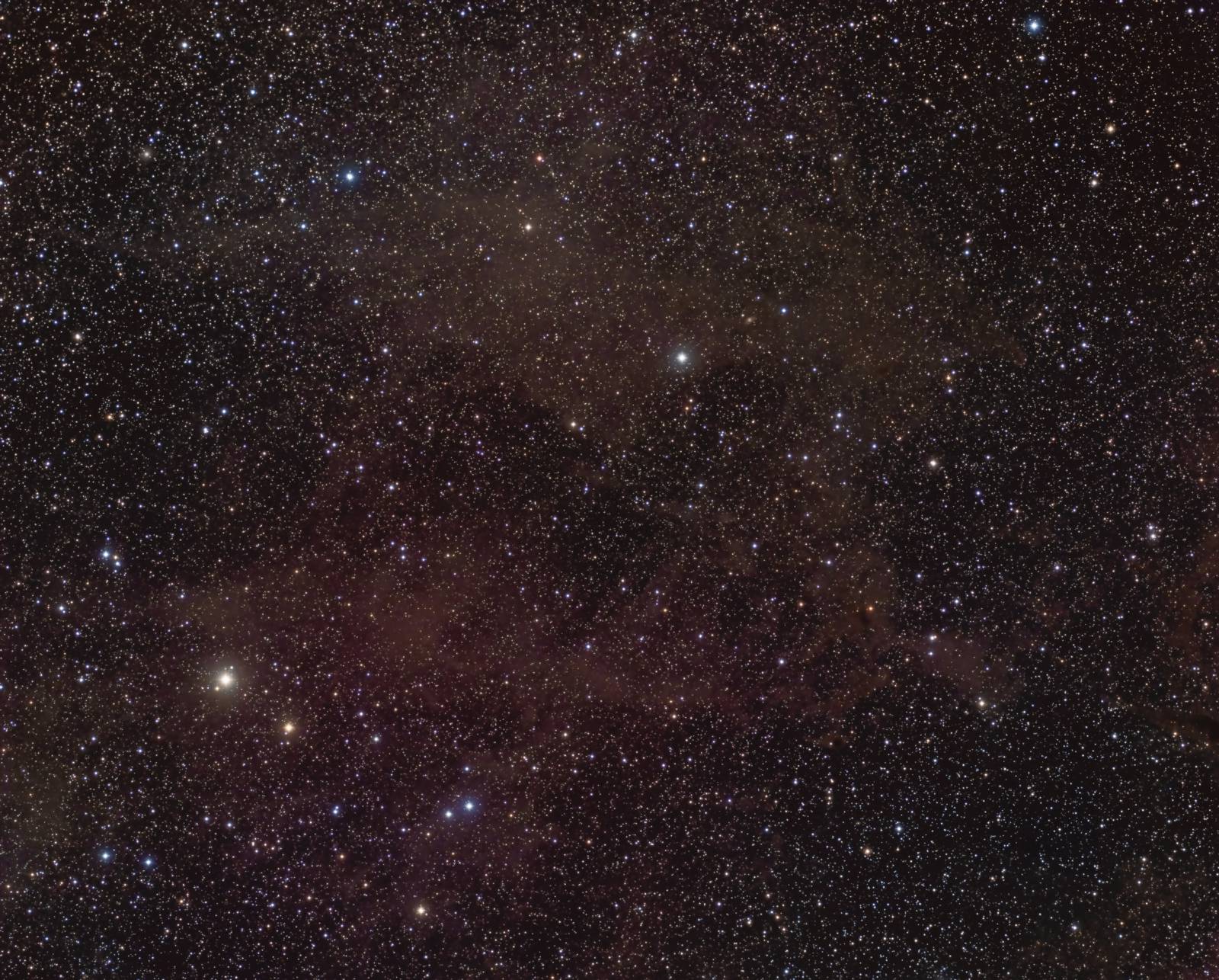LBN 459
 Click image for full size version
Click image for full size version
April 28, 2018
LBN 459 is a member of the catalogue of Lynd’s Bright Nebulae (LBN). Contrary to the catologue’s name, many LBN objects are barely-there clouds of interstellar dust. LBN 459 looks similar to the dust surrounding the Iris Nebula, which lies about 4.5 degrees (9 moon widths) away. Assuming both belong to the same complex of dust, LBN lies around 1,300 light years distant. It is quite large – more than 2 degrees on the sky. These clouds are also known as “molecular clouds.”
This is an exciting catch for me because I have not been able to find any other images of it on the internet. This may be the first colour image of this object. The LBN catalogue was compiled by Beverly T. Lynd in 1965, from examination of the red and blue prints of the National Geographic – Palomar Observatory Sky Atlas. Some LBN objects are well known, like the Orion Nebula. Others, like LBN 459, are obscure and rarely, if ever, imaged.
Tekkies:
Moravian G3-16200 EC camera, Optolong R, G and B filters, Takahashi FSQ-106 ED IV at f/3.6, Paramount MX, guided with QHY5 camera and 175mm guidescope. Acquisition with the SkyX, focused with FocusMax. Scripted with CCD Commander. All pre-processing and processing in PixInsight. Acquired from my SkyShed in Guelph on April 22-23, 2018. No Moon. Excellent transparency and average seeing.
7x10m R, 6x10m G and 6x10m B unbinned frames (total=3hr10m).
Pre-Processing
The BatchPreProcessing script was used to perform calibration, cosmetic correction and registration of all frames. ImageIntegration was used to make R, G and B masters.
RGB Creation
Creation and cleanup: R, G and B were cropped to remove edge artifacts and processed with DynamicBackgroundExtraction. They were combined to make an RGB image which was colour balanced using PhotometricColorCalibration.
Linear Noise Reduction: MultiscaleLinearTransform was used to reduce noise. The linear mask feature was used to protect bright stars and brighter areas of the nebulae. Layer settings for threshold and strength: Layer 1: 3.0 0.75 Layer 2: 2.0, 0.650 Layer 3: 1.5., 0.5 .
Stretching: HistogramTransformation was applied to make a pleasing, bright image.
Noise Reduction and Re-Stretch: TGVDenoise was applied in L*a*b* mode with 300 iterations with a range mask applied to protect stars. HistogramTransformation was then applied to raise the black point, darkening the background slightly (but with no clipping).
Synthetic Luminance
Creation and cleanup of SynthL: The three channel masters were integrated (average, noise weighted, no rejection) using ImageIntegration to create the SynthL.
Linear Noise Reduction: MultiscaleLinearTransform was used to reduce noise in the background areas. Layer settings for threshold and strength: Layer 1: 3.0 0.7 Layer 2: 2.0, 0.40 Layer 3: 1.5, 0.20.
Stretching: HistogramTransformation was applied to the SynthL to make a pleasing, bright image.
Noise Reduction and Re-Stretch: TGVDenoise was applied in L*a*b* mode with 300 iterations with a range mask applied to protect stars. This was followed by an application of HistogramTransformation to raise the black point (but with no clipping).
Combining SynthL with RGB
LRGBCombine was used to apply the SynthL to the RGB.
Additional Processing
Background and star brightness, contrast and saturation were adjusted in several iterations using Curves with masks as required.
Image scale is about 3.2 arcsec per pixel for this camera/telescope combination, scaled to 6.4 arcsec per pixel.






What a rare gem! I like how you picked up and preserved the nebulosity with the Stars. Interesting history as well. Well done!
Very nicely done! Always glad to see something new!!